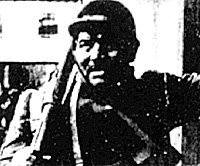 We stayed in Sedan and, despite the weather, we did most of the
battlefields within easy driving distance. Waterloo, of course, was a must and we arrived there via Quatre Bras. Nearer at hand was Bazeilles, with its Maison de la Derniere Cartouche, This is a building held by about a hundred French sailors against a Bavarian regiment. They held it for a couple of days until all their ammunition had gone and half of them were dead. The Bavarians counted 600 of their men dead and accorded the French full honours when they surrendered.
We stayed in Sedan and, despite the weather, we did most of the
battlefields within easy driving distance. Waterloo, of course, was a must and we arrived there via Quatre Bras. Nearer at hand was Bazeilles, with its Maison de la Derniere Cartouche, This is a building held by about a hundred French sailors against a Bavarian regiment. They held it for a couple of days until all their ammunition had gone and half of them were dead. The Bavarians counted 600 of their men dead and accorded the French full honours when they surrendered.
When the Bavarians burnt the town as a reprisal for sniping they spared only this building, which is now a museum. The room where the last shots were fired from has been left largely untouched. All the original furniture is in place, but only small patches of the wallpaper remain. It is well worth a visit, but be warned, the guide likes his garlic! All along the Meuse valley are blockhouses and pill boxes of the Maginot Line extension. Sedan also has a very interesting old fort, a part of which is a museum devoted to the Carolingian and Merovingian periods of European history.
Verdun
We also paid a visit to Verdun and this was an unforgettable experience. The battlefield has been largely planted with trees, but the trees grow among clearly defined shell craters and it is quite impossible to walk in these woods. The Trench of Bayonets is still visible under a concrete cover. A company of infantry were waiting to go over the top, when the trench collapsed on them and only the rifle muzzles and bayonets were visible. The bodies were left and although the bayonets have rusted away, the rifles are still visible. My son Andrew and I scrambled through waterlogged shell holes and rank horse to have a look at Fort Thiaumont. It needed little imagination to build up a picture of what it was like during a lull in the fighting. On this ground there was an unpleasant smell, quite unlike anything I have experienced before.
Fort Douaumont remains much as it was in 1918 after the fighting ended. The only external damage visible is where a 420cm shell landed near the entrance. It is maintained as a memorial not only to the French who died there, but to the Germans also. The German signs put up after its capture still remain and many parts are shut off. In these parts are unnumbered French and German dead it was not possible to bury.
To give an example of the noise during a bombardment our guide let off a small thunderflash, which echoed for several seconds through the galleries. Four days was the maximum period men could remain there, and even then only the strongest remained sane. One could well believe a French company commander who reported simply when relieved: "My company went in 175 strong. Now only 30 remain and some of them are mad."
It is peaceful now and hundreds of thousands of men lie at rest there. For the majority, all that remains of them is a name on a brick in the large memorial building.
From the top of the building one gets a fine view of the whole battlefield. Inside are relics of the battle. There is also a museum, which includes a large map of the whole battle area and the story of the fighting is explained at regular intervals. Most of the notices are in French, English and German, so there is no language difficulty. But it is the reports of the men just out of the front line that bring home to one what existence on the Western Front was like. I bought an interesting book at Douaumont called L'Enfer de Verdun (The Hell of Verdun). It is based on stories and reports by participants in the fighting and one does not have to read very much to realise that the title is an understatement. We did not visit Fort Vaux; we had just about had enough of man's inhumanity to himself.
After all this Luxembourg and its magnificent fort was just light relief. We only paid it a quick visit, but intend returning another year.
Back to Table of Contents -- Wargamer's Newsletter # 131
To Wargamer's Newsletter List of Issues
To MagWeb Master Magazine List
© Copyright 1973 by Donald Featherstone.
This article appears in MagWeb.com (Magazine Web) on the Internet World Wide Web.
Other articles from military history and related magazines are available at http://www.magweb.com